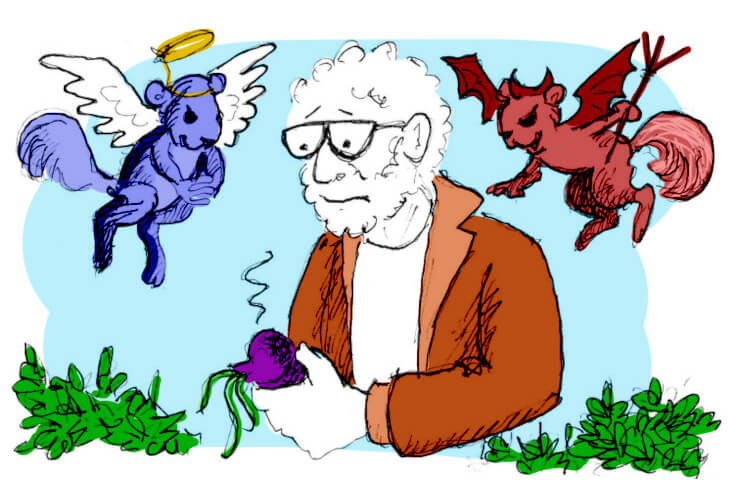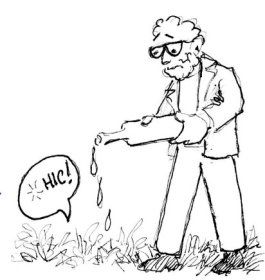Read by Michael Flamel

As I have previously recounted in these pulse-pounding pages, the amazingly talented Hall of Fame ballplayer Rogers Hornsby (third-best batting average in all of baseball history!) was once asked by a reporter, “What do you do in the off-season?”
“You want to know what I do in the Winter? I’ll tell you what I do in the Winter. I look out the window and dream of Spring.”
I can visualize “The Rajah” (his ballpark nickname) sitting in a chair close to that mythical window and twirling a bat in his hands from October through March. I did surprisingly well as a hitter in my own playing days, but my off season security blanket is a well-broken-in fielder’s glove and an official Major League hardball. Unlike Steve McQueen in The Great Escape, however, I have not been confined to “the cooler” (yet) and have to be satisfied with “pitching” the ball into my glove for an hour at a pop while, yes, I stare out the window……and dream of garlic. Sometimes it’s a nightmare of neck rot; sometimes it’s a hard-neck paradise of beautiful bulbs, but for now I stare out at my garden and see lightly snow-covered sprouts. Like a ballpark idled in January, those sprouts offer hope for Spring, Summer, and if you’re lucky, Fall. Or disaster, ruin, and a last-place finish.
Which fate awaits me down there under the snow and the soil???!!!
I built the garden some 35 years ago. About five years after that I was speaking at a Master Gardener conference somewhere and a rep for Johnny’s Selected Seeds handed me a couple heads of some fine-looking garlic and told me to plant the individual cloves in my best soil that Fall. A short time later, a farmer friend gave me a few of his heads. Then I visited the late master garlic grower Frank Pollack, who gave up a bit of his harvest, and, more importantly, tried to teach me the growing process. I planted and was now a garlic grower-to-be.

In late Spring of the following year, I clipped the scapes off of dozens of my perfect plants and later harvested big, beautiful bulbs. Success! I began preaching the Garlic Gospel to all who would listen: “A foolproof crop!” “Practically grows itself!”
This went on for years, with me replanting my biggest cloves every season; eventually I was harvesting big perfect bulbs, most of which contained only four huge cloves. Then a seed preservation company decided I had created a new and unique strain, perfectly adapted to my climate, soil, tender mercies, and opposable thumbs. Yes!
By now I was growing anywhere between 100-150 heads a season and kept preaching, “Grow garlic! It’s foolproof!”
And, of course, I was the fool about to disabuse myself of that fantasy.
By late May of that year the garlic beds were once again filled with gorgeous green plants. I cut (and sautéed) the scapes. Next I would begin harvesting when the bottom third of the plants had turned brown. La de da; what a great garlic grower am I!
About a week later I noticed that some of the plants were all brown. And skinny. My perfect sea of green had been polluted! But the worst was yet to come. When I tugged on one of the seemingly deceased plants, it came right out of the soil. It did not snap off at the soil line; it just kind of gave up the ghost and joined the Garden Invisible.
Then I saw that it was not alone. Every all-brown plant seemed to be waiting for someone to lift it out and end its misery. I frantically dug into the soil underneath where infected plants had been. In some places, there was a pitiful little misshapen pile of nasty-looking cloves. In some other cases, nothing. “Okay, you can fix this” said a small angel on my shoulder that looked suspiciously like an Evil Squirrel wearing one of those grade school haloes where you could see the big wire holding it in place, flimsy fake wings and a white ro…rob…robe…wait a minute! That’s my missing handkerchief!
But before I could react, there was another Evil Squirrel on my other shoulder holding a pitchfork made out of a swizzle stick and two toothpicks, laughing “FOOL proof! HA! Ha! FOOL proof!”
I shook them off, cleared my head and went after the other Bad Plants, always with the same sad result. At the bottom of each useless garlic stick there was a line of mold. I decided to call this affliction “neck rot;” probably because I knew I could use the line in one of my talks: “Last year, tragedy struck in the form of neck rot. And my garlicdidn’t look so good either!” Badda boom.
But my situation was less funny than that pitiful joke. I hoped that removing all the affected plants would help …
It did not. Every day there were more
Then I foolishly hoped that my garlic had matured two months early and pulled up a green plant …
Which looked like a skinny leek that the guy on the beach in comic book ads would have kicked sand at.
I watched helplessly as my soldiers fell one by one. I decided to carefully mark the Beds of Death and rotate my garlic that Fall. But wait a minute! What garlic?! I didn’t harvest a single decent head. Was my strain suddenly extinct?!
Luckily, I had been unusually generous with my garlic over the years, and two friends had good harvests of “my seed” that Summer, which they generously shared with me. My strain was saved!
But what about the future? A little research revealed that many pathogens cause similar symptoms and that they persist in the soil for at least ten years, maybe forever. (I hoped I had another ten years ahead of me, but probably not forever.) No cures were listed; this was the Black Death of alliums!
I had no choice but to try the Hail Mary Pass of crop rotation. I pulled up non-garlic plants that had not yet reached their full potential, mixed lots of compost and perlite into their soil, and planted my rescued cloves.
Maybe the Evil Squirrel had been hit by a car or taunted my family of red-tailed hawks one too many times, but it worked! My strain was saved! No neck rot! (And none on the garlic either …) (“Don’t forget to tip your server; and for God’s sake DO NOT try the veal!”)
I actually practiced serious garlic crop rotation afterwards (as opposed to rotating my tomatoes, which I simply lie about). But about five years later—this past season—I began to see the little Stalks of Death appear once again. “Oh [bad word]; it’s happening again!
Then I remembered one of my favorite tips we published back when I was Editor-in-Chief of Organic Gardening magazine: To prevent disease, soak your planting cloves in a solution of baking soda overnight, run them through a five-minute bath of vodka, and then plant. But my cloves were already in the ground, and I wasn’t sure if anyone I knew was still growing my strain.

Blind panic. Rending of garments and gnashing of teeth. Then, inspiration! (Kind of.)
I sped to the local State Store (excuse me, “Wine and Spirits Shop.” They used to be called State Stores in Pennsylvania when I was growing up, and I was convinced that you could walk into one of these places and purchase Delaware) and started rooting around the vodka aisle. I had picked up a regular size bottle (750 ml) that looked promisingly vile when a clerk came over and asked if he could help me. I said, “Is this your cheapest vodka?”
“Hardly,” he answered and handed me a half-gallon bottle of “premium” (so called because it smelled like high-test gasoline) vodka that cost a whopping ten bucks. I went home and proceeded to pour this swill into my garlic beds. The browning seemed to slow down, then stopped. I harvested a good hundred heads of gorgeous garlic. That was in July.
In early September, I rotated again, and gave each clove the baking soda and vodka bath. After that, it was in the hands of the Gardening Gods.
Now it is Winter. The garlic rests, but I do not. What’s going on down there? I wonder, staring out the window at their bed. Oh, cloves, my cloves, will you reach the apex of perfection? Or—No!—the nadir of neck rot?
Only time—and my garlic—will tell. ❖


 Previous
Previous


